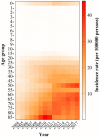Feasibility of Hepatitis C Elimination in China: From Epidemiology, Natural History, and Intervention Perspectives
- PMID: 35722351
- PMCID: PMC9201439
- DOI: 10.3389/fmicb.2022.884598
Feasibility of Hepatitis C Elimination in China: From Epidemiology, Natural History, and Intervention Perspectives
Abstract
Hepatitis C imposes a heavy burden on many countries, including China, where the number of reported cases and the incidence of hepatitis C virus (HCV) increased yearly from 2005 to 2012, with a stable trend after 2012. The geographical distribution of HCV infections varies widely in China, with the northwest and southwest regions and the Henan Province showing a high disease burden. Elderly, men, sexually active people, drug users, migrants, blood transfusion recipients, and renal dialysis patients have become the target populations for hepatitis C prevention and control. It is important to improve the diagnosis rate in high-risk groups and asymptomatic people. Identifying secondary HCV infections, especially in HCV patients co-infected with the human immunodeficiency virus (HIV) is a priority of hepatitis C prevention and control. Enhancing universal access to direct antiviral agents (DAAs) treatment regimens is an effective way to improve the cure rate of HCV infection. For China to contribute to the WHO 2030 global HCV elimination plan, strategic surveillance, management, and treatment program for HCV are needed.
Keywords: elimination; epidemiology; hepatitis C; interventions; natural history.
Copyright © 2022 Zhao, Chu, Guo, Yang, Abudurusuli, Frutos and Chen.
Conflict of interest statement
The authors declare that the research was conducted in the absence of any commercial or financial relationships that could be construed as a potential conflict of interest.
Figures





References
-
- AASLD/IDSA HCV Guidance Panel. Chung R. T., Davis G. L., Jensen D. M., Masur H., Saag M. S., et al. . (2015). Hepatitis C guidance: AASLD-IDSA recommendations for testing, managing, and treating adults infected with hepatitis C virus. Hepatology 62, 932–954. doi: 10.1002/hep.27950, PMID: - DOI - PubMed
-
- Abdelhakam S. A., Othman M. A. (2018). “Social, cultural, and political factors influencing HCV in developing countries,” in. Hepatitis C in Developing Countries. 33–38.
-
- Bao Y., Larney S., Peacock A., Colledge S., Grebely J., Hickman M., et al. . (2019). Prevalence of HIV, HCV and HBV infection and sociodemographic characteristics of people who inject drugs in China: A systematic review and meta-analysis. Int. J. Drug Policy 70, 87–93. doi: 10.1016/j.drugpo.2019.05.005, PMID: - DOI - PMC - PubMed
Publication types
LinkOut - more resources
Full Text Sources

